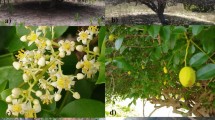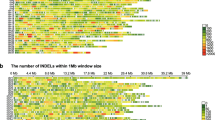Abstract
Single nucleotide polymorphisms (SNPs) are the most abundant and richest form of genomic polymorphism and, hence, are highly favorable markers for genetic map construction and genome-wide association studies. Based on the DNA specific-locus amplified fragment sequencing (SLAF-seq) for large-scale SNP detection, the genetic diversity and population structure of Salix gordejevii Y. L. Chang et Skv., a valuable sand-fixing shrub, was assessed in 199 accessions from 20 populations in Hunshandake Sandland of northern China. A total of 623.15 M reads resulted in 30.49 × sequencing depth on average and a mean Q30 of 95.70%, and 2,287,715 SNPs in 178,509 polymorphic SLAF tags were obtained. By discarding minor allele frequency > 0.05 and integrity > 0.8, a total of 93,600 SNPs were retained for population genetic analyses, which revealed that 199 individuals could be divided into six groups based on cross-validation errors. However, this grouping pattern did not match the geographical distribution, indicating that there is no apparent geographic barrier in the blank areas where S. gordejevii was not distributed in Hunshandake Sandland. In addition, the physical distance of linkage disequilibrium decay in the analyzed S. gordejevii individuals was 18.5 kb when r2 = 0.1. The linkage disequilibrium decay distances for different chromosomes varied from 4.6 kb (chromosome 16) to 37.8 kb (chromosome 3). The obtained SNPs offer suitable marker resources for further genetic and genomic studies and will benefit S. gordejevii breeding programs.





Similar content being viewed by others
Data availability
The data will be available publically after the acceptance of the manuscript.
References
Alexander DH, Novembre J, Lange K (2009) Fast model-based estimation of ancestry in unrelated individuals. Genome Res 19:1655–1664
Barrett JC, Fry B, Maller J, Daly MJ (2005) Haploview: analysis and visualization of LD and haplotype maps. Bioinformatics 21:263–265. https://doi.org/10.1093/bioinformatics/bth457
Bradbury PJ, Zhang Z, Kroon DE, Casstevens TM, Ramdoss Y, Buckler ES (2007) TASSEL: software for association mapping of complex traits in diverse samples. Bioinformatics 23:2633–2635. https://doi.org/10.1093/bioinformatics/btm308
Chen JH, Huang Y, Brachi B, Yun QZ, Zhang W, Lu W, Li HN, Li WQ, Sun XD, Wang GY, He J, Zhou Z, Chen KY, Ji YH, Shi MM, Sun WG, Yang YP, Zhang RG, Abbott RJ, Sun H (2019) Genome-wide analysis of Cushion willow provides insights into alpine plant divergence in a biodiversity hotspot. Nat Commun 10:5230. https://doi.org/10.1038/s41467-019-13128-y
Chen SQ, Huang ZF, Dai Y, Qin SW, Gao YY, Zhang LL, Gao Y, Chen JM (2013) The development of 7E chromosome-specific molecular markers for Thinopyrum elongatum based on SLAF-seq technology. PLoS ONE 8:e65122. https://doi.org/10.1371/journal.pone.0065122
Cui XP, Liu GH, Zhang CH (2011) Root distribution and biomass of Salix gordejevii in hunshandake sandland. J Desert Res 31:447–450
Du Y, Jiang H, Chen Y, Li C, Zhao M, Wu J, Qiu Y, Li Q, Zhang X (2012) Comprehensive evaluation of SNP identification with the restriction enzyme-based reduced representation library (RRL) method. BMC Genom 13:77
Hardy OJ, Vekemans X (2002) SPAGeDi: a versatile computer program to analyse spatial genetic structure at the individual or population levels. Mol Ecol Notes 2:618–620. https://doi.org/10.1046/j.1471-8286.2002.00305.x
He J, Zhao X, Laroche A, Lu ZX, Liu H, Li Z (2014) Genotyping-by-sequencing (GBS), an ultimate marker-assisted selection (MAS) tool to accelerate plant breeding. Front Plant Sci 5:484
Huang WD, Zhao XY, Zhao X, Li YL, Feng J, Su N, Pan CC, Luo YY (2018) Environmental determinants of genetic diversity in Salix gordejevii (Salicaceae) in three Sandy Lands, northern Chin. Acta Oecol 92:67–74
Huang WD, Zhao XY, Zhao X, Luo YY, Feng J, Su N, He YZ (2019) Genetic diversity in Salix gordejevii populations from different environmental gradients in Horqin Sandy Land, Northern China. Pol J Ecol 67:175–185
Jiang GM (2003) On the restoration and management of degraded ecosystems: with special reference of protected areas in the restoration of degraded lands. Chin Bull Bot 20:373–382
Kent WJ (2002) BLAT-the BLAST-like alignment tool. Genome Res 12:656–664. https://doi.org/10.1101/gr.229202
Kilian B, Özkan H, Kohl J, von Haeseler A, Barale F, Deusch O, Brandolini A, Yucel C, Martin W, Salamini F (2006) Haplotype structure at seven barley genes: relevance to gene pool bottlenecks, phylogeny of ear type and site of barley domestication. Mol Genet Genom 276:230–241
Kozich JJ, Westcott SL, Baxter NT, Highlander SK, Schloss PD (2013) Development of a dual-index sequencing strategy and curation pipeline for analyzing amplicon sequence data on the MiSeq Illumina sequencing platform. Appl Environ Microb 79:5112–5120. https://doi.org/10.1128/AEM.01043-13
Kumar S, Banks TW, Cloutier S (2012) SNP discovery through next-generation sequencing and its applications. Int J Plant Genom 2012:831460
Kumar S, Stecher G, Li M, Knyaz C, Tamura K (2018) MEGA X: molecular evolutionary genetics analysis across computing platforms. Mol Eiol Evol 35:1547–1549
Li B, Tian L, Zhang J, Huang L, Han F, Yan S, Wang L, Zhang H, Sun J (2014) Construction of a high-density genetic map based on large-scale markers developed by specific length amplified fragment sequencing (SLAF-seq) and its application to QTL analysis for isoflavone content in Glycine max. BMC Genom 15:1086. https://doi.org/10.1186/1471-2164-15-1086
Li H, Durbin R (2009) Fast and accurate short read alignment with burrows-wheeler transform. Bioinformatics 25:1754–1760. https://doi.org/10.1093/bioinformatics/btp324
Li H, Handsaker B, Wysoker A, Fennell T, Ruan J, Homer N, Marth G, Abecasis G, Durbin R (2009) The sequence alignment/map format and SAMtools. Bioinformatics 25:2078–2079. https://doi.org/10.1093/bioinformatics/btp352
Mammadov J, Aggarwal R, Buyyarapu R, Kumpatla S (2012) SNP markers and their impact on plant breeding. Int J Plant Genom 2012:728398
McKenna A, Hanna M, Banks E, Sivachenko A, Cibulskis K, Kernytsky A, Garimella K, Altshuler D, Gabriel S, Daly M, DePristo M (2010) The genome analysis toolkit: a mapreduce framework for analyzing next-generation DNA sequencing data. Genome Res 20:1297–1303. https://doi.org/10.1101/gr.107524.110
Miller MR, Dunham JP, Amores A, Cresko WA, Johnson EA (2007) Rapid and cost-effective polymorphism identification and genotyping using restriction site associated DNA (RAD) markers. Genome Res 17:240–248
Niu SL, Jiang GM, Wan SQ, Li YG, Gao LM, Liu MZ (2006) A sandfixing pioneer C3 species in sandland displays characteristics of C4 metabolism. Environ Exp Bot 57:123–130
Price AL, Patterson NJ, Plenge RM, Weinblatt ME, Shadick NA, Reich D (2006) Principal components analysis corrects for stratification in genome-wide association studies. Nat Genet 38:904–909
Purcell S, Neale B, Todd-Brown K, Lori T, Ferreira M, Bender D, Maller J, Pamela S, Bakker P, Daly MJ, Sham PC (2007) PLINK: a tool set for whole-genome association and population-based linkage analyses. Am J Human Genet 81:559–575
Shen C, Jin X, Zhu D, Lin ZX (2017) Uncovering SNP and indel variations of tetraploid cottons by SLAF-seq. BMC Genom 18:247
Sun R, Chang Y, Yang F, Wang Y, Li H, Zhao Y, Chen D, Wu T, Zhang X, Han Z (2015) A dense SNP genetic map constructed using restriction site-associated DNA sequencing enables detection of QTLs controlling apple fruit quality. BMC Genom 16:747
Sun X, Liu D, Zhang X, Li W, Liu H, Hong W, Jiang C, Ning G, Ma C, Zeng H (2013) SLAF-seq: an efficient method of large-scale de novo SNP discovery and genotyping using high-throughput sequencing. PLoS ONE 8:e58700. https://doi.org/10.1371/journal.pone.0058700
Su H, Li Y, Lan Z, Hong X, Liu W, Wang B, Biswas DK, Jiang G (2009) Leaf-level plasticity of Salix gordejevii in fixed dunes compared with lowlands in Hunshandake Sandland, North China. J Plant Res 122:611–622
Su W, Wang L, Lei J, Chai S, Liu Y, Yang Y, Yang X, Jiao C, Sun G (2017) Genome-wide assessment of population structure and genetic diversity and development of a core germplasm set for sweet potato based on specific length amplified fragment (SLAF) sequencing. PLoS ONE 12(2):e0172066. https://doi.org/10.1371/journal.pone.0172066
Su YZ, Zhang TH, Li YL, Wang F (2005) Changes in soil properties after establishment of Artemisia halodendron and Caragana microphylla on shifting sand dunes in semiarid Horqin sandy land, Northern China. Environ Manag 36:272–281
Tuskan GA, Difazio S, Jansson S, Bohlmann J, Grigoriev I, Hellsten U, Putnam N, Ralph S, Rombauts S, Salamov A (2006) The genome of black cottonwood, Populus trichocarpa (Torr. & Gray). Science 313:1596–1604
Wei QZ, Wang WH, Hu TH, Hu HJ, Wang JL, Bao C (2020) Construction of a SNP-based genetic map using SLAF-Seq and QTL analysis of morphological traits in eggplant. Front Genet 11:178
Xia C, Chen LL, Rong TZ, Li R, Xiang Y, Wang P, Liu CH, Dong XQ, Liu B, Zhao D (2015) Identification of a new maize inflorescence meristem mutant and association analysis using SLAF-seq method. Euphytica 202:35–44. https://doi.org/10.1007/s10681-014-1202-5
Xie DW, Dai ZG, Yang ZM, Tang Q, Sun J, Yang X, Song XX, Lu Y, Zhao DB, Zhang LG, Su JG (2018) Genomic variations and association study of agronomic traits in flax. BMC Genom 19:512. https://doi.org/10.1186/s12864-018-4899-z
Xia W, Luo TT, Zhang W, Mason AS, Huang DY, Huang XL, Tang WQ, Dou YJ, Zhang CY, Xiao Y (2019) Development of high-density SNP markers and their application in evaluating genetic diversity and population structure in Elaeis guineensis. Front Plant Sci 10:130. https://doi.org/10.3389/fpls.2019.00130
Yahiaoui S, Igartua E, Moralejo M, Ramsay L, Molina-Cano JL, Lasa JM, Gracia MP, Casas AM (2008) Patterns of genetic and ecogeographical diversity in Spanish barleys. Theor Appl Genet 116:271–282
Yan QL, Liu ZM, Ma JL, Jiang DM (2007) The role of reproductive phenology, seedling emergence and establishment of perennial Salix gordejevii in active Sand dune fields. Ann Bot 99:19–28
Yang JD, Zhao HL, Zhang TH (2004) Heat and drought tolerance of two willow species, Salix gordejevii and Salix babylonica: a comparative study. Isr J Plant Sci 52:301–306
Yuan Z, Li LH, Han XG, Huang JH, Wan SQ (2005) Foliar nitrogen dynamics and nitrogen resorption of a sandy shrub Salix gordejevii in northern China. Plant Soil 278:183–193
Yu JM, Pressoir G, Briggs WH, Vroh Bi I, Yamasaki M, Doebley JF, McMullen MD, Gaut BS, Nielsen DM, Holland JB, Kresovich S, Buckler ES (2006) A unified mixed-model method for association mapping that accounts for multiple levels of relatedness. Nat Genet 38:203–208. https://doi.org/10.1038/ng1702
Zhang RL, Liu GH, Cui XP (2006) Effects of living Salix gordejevii Barrier on wind breaking and sand fixation in Hunshandake Sandland. J Desert Res 26:717–721
Zhang Z, Shang HH, Shi YZ, Huang L, Li JW, Ge Q, Gong JW, Liu AY, Chen TT, Wang D, Wang YL, Palanga KK, Muhammad J, Li WJ, Lu QW, Deng XY, Tan YN, Song WW, Cai J, Li PT, Rashid H, Gong WK, Yuan YL (2016) Construction of a high-density genetic map by specific locus amplified fragment sequencing (SLAF-seq) and its application to quantitative trait (QTL) analysis for boll weight in upland cotton (Gossypium hirsutum). BMC Plant Biol 16:79. https://doi.org/10.1186/s12870-016-0741-4
Zhou Q, Zhou C, Zheng W, Mason AS, Fan S, Wu C, Fu D, Huang Y (2017) Genome-wide SNP markers based on SLAF-Seq uncover breeding traces in rapeseed (Brassica napus L.). front. Plant Sci 8:648. https://doi.org/10.3389/fpls.2017.00648
Funding
This research was financially supported by the program of Research Program of Science and Technology at Universities of Inner Mongolia Autonomous Region (NJZZ19185) and “The biogeographical feature and competitive hybridization of Maple (Acer L.) in East Asia” of National Natural Science Foundation of China (41901063) to J.G., the Program of Science and Technology of Inner Mongolia Autonomous Region (201605052) to X.-L.N.
Author information
Authors and Affiliations
Contributions
J.G. and X.-L.N. conceived and designed the work; J.G. collected samples; J.G. performed the experiments and analysed the data; J.G. wrote the manuscript; X.-L.N. critically reviewed the manuscript. All authors have read and agreed to the published version of the manuscript.
Corresponding author
Ethics declarations
Conflicts of interest
The authors declare no conflict of interest.
Ethical approval
The authors declare that all experiments described herein comply with the law of government in which they were carried out. All plant materials used in this study are legally obtained and/or collected.
Additional information
Publisher's Note
Springer Nature remains neutral with regard to jurisdictional claims in published maps and institutional affiliations.
Supplementary Information
Below is the link to the electronic supplementary material.
Rights and permissions
About this article
Cite this article
Gao, J., Ning, XL. SNP detection and population structure evaluation of Salix gordejevii Y. L. Chang et Skv. in Hunshandake Sandland, Inner Mongolia, China. Physiol Mol Biol Plants 27, 997–1005 (2021). https://doi.org/10.1007/s12298-021-00994-4
Received:
Revised:
Accepted:
Published:
Issue Date:
DOI: https://doi.org/10.1007/s12298-021-00994-4




